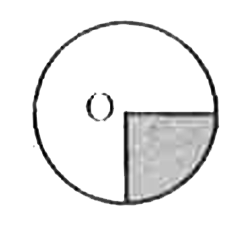The M.I. of a ring and disc of same mass and radius about their geometric axes will be:
more for the disc
more for the ring
eual in both cases
none of these.
The correct Answer is:B
To solve the problem of comparing the moment of inertia (M.I.) of a ring and a disc of the same mass and radius about their geometric axes, we can follow these steps:
Step 1: Understand the Shapes
- A ring is a hollow circular object with mass distributed along its circumference.
- A disc is a solid circular object with mass distributed throughout its area.
Step 2: Identify the Moment of Inertia Formulas
- The moment of inertia I of a ring about its geometric axis (which is perpendicular to the plane of the ring and passes through its center) is given by:
Iring=mR2
where m is the mass and R is the radius of the ring.
- The moment of inertia I of a disc about its geometric axis (which is also perpendicular to the plane of the disc and passes through its center) is given by:
Idisc=12mR2
Step 3: Substitute the Values
- Since both the ring and the disc have the same mass m and radius R, we can directly compare their moments of inertia:
- For the ring:
Iring=mR2
- For the disc:
Idisc=12mR2
Step 4: Compare the Moments of Inertia
- Now, we can compare the two expressions:
Iring=mR2andIdisc=12mR2
- Clearly, Iring>Idisc.
Conclusion
- The moment of inertia of the ring is greater than that of the disc. Therefore, the answer is:
Iring>Idisc
- A ring is a hollow circular object with mass distributed along its circumference.
- A disc is a solid circular object with mass distributed throughout its area.
- The moment of inertia I of a ring about its geometric axis (which is perpendicular to the plane of the ring and passes through its center) is given by:
Iring=mR2
where m is the mass and R is the radius of the ring.
Idisc=12mR2
- Since both the ring and the disc have the same mass m and radius R, we can directly compare their moments of inertia:
- For the ring:
Iring=mR2
- For the disc:
Idisc=12mR2
- Now, we can compare the two expressions:
Iring=mR2andIdisc=12mR2
- Clearly, Iring>Idisc.
- The moment of inertia of the ring is greater than that of the disc. Therefore, the answer is:
Iring>Idisc
Similar Questions
The M.I. of a disc of mass M and radius R, about an axis passing through the centre O and perpendicular to the plane of the disc is MR22 . If one quarter of the disc is removed, the new moment of inertia of the disc will be

View SolutionCalculate the ration of radii of gyration of circular ring and a disc of the same radius about the axis passing through their centres and perpendicular to their planes.
View Solution
Knowledge Check
The ratio of the radii of gyration of a circular disc to that of a circular ring, each of same mass and radius, around their respective axes is.
A√3:√2B1:√2C√2:1D√2:√3The ratio of the radii of gyration of a circular disc to that of a circular ring, each of same mass and radius, around their respective axes is.
A√2:√3B√3:√2C1:√2D√2:1The M.I. of a ring of mass M and radius R about a tangential axis perpendicular to its plane is :
A2MR2BMR2C3/2MR2D3/4MR2
Moment of inertia of a disc of mass 'M' and radius 'R' about the diameter is
View SolutionThe M.I. of a thin ring of mass M and radius R about an axis through the diameter in its plane will be:
View SolutionThe M.I. of a uniform semicircular disc of mass M and radius R about a line perpendicular to the plane of the disc and passing through the centre is
View SolutionThe ratio of radii of gyration of a circular ring and a circular disc, of the same mass and radius about an axis passing through their centres and perpendicular to their planes are
View SolutionA thin ring and a solid disc of same mass and radius are rolling with the same linear velocity. Then ratio of their kinetic energies is
View Solution
